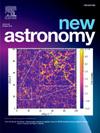四个选定的行星状星云的光谱学和光电离模型
IF 2.1
4区 物理与天体物理
Q2 ASTRONOMY & ASTROPHYSICS
引用次数: 0
摘要
我们展示了从HASH(香港/澳大利亚天文台/斯特拉斯堡h - α行星状星云)数据库中选择的北半球四个致密行星状星云(PNe)的化学丰度测量结果。光谱数据的收集使用中分辨率的TUG暗天体光谱仪和安装在TÜBİTAK国家天文台1.5 m RTT望远镜上的相机。对于每个物体,我们确定了关键的物理参数,包括消光系数、电子密度、电子温度和电离校正因子。此外,我们利用先进的光电离建模和cloudy代码构建了每个PN跨多个波长的光谱能量分布。元素丰度分析,重点是He, N, O, Ne, S, Cl和Ar,表明这些PNe的化学组成与太阳和银河系的值一致。中心恒星的有效温度大约在53,000到180,000 K之间,光度在2,500到9,000 L⊙之间。根据它们在H-R图上的位置和agb后的演化轨迹,它们的初始质量估计在1到3 M⊙之间,星云质量在0.69到2.34 M⊙之间。该星云的年龄在300年到5000年之间,与之前的发现一致,强调了它们在进化中的重要性。本文章由计算机程序翻译,如有差异,请以英文原文为准。
Optical spectroscopy and photoionization modeling of four selected planetary nebulae
We present the results of chemical abundance measurements for four compact planetary nebulae (PNe) located in the Northern Hemisphere, selected from the HASH (Hong Kong/Australian Astronomical Observatory/Strasbourg H-alpha Planetary Nebula) database. Spectral data were collected using the medium-resolution TUG Faint Object Spectrograph and Camera mounted on the 1.5 m RTT telescope at the TÜBİTAK National Observatory. For each object, we determined key physical parameters, including the extinction coefficient, electron density, electron temperature, and ionization correction factors. Additionally, we constructed the spectral energy distribution across multiple wavelengths for each PN using advanced photoionization modeling with the cloudy code. The elemental abundance analysis, focusing on He, N, O, Ne, S, Cl, and Ar, indicates that the chemical composition of these PNe is consistent with both solar and Galactic values. The central stars exhibit effective temperatures ranging from approximately 53,000 to 180,000 K and luminosities between 2,500 and 9,000 L. Based on their positions on the H-R diagram and post-AGB evolutionary tracks, their initial masses are estimated to range from 1 to 3 M, with nebular masses between 0.69 and 2.34 M. The ages of the nebulae, calculated to be between 300 and 5,000 years, align with previous findings, emphasizing their evolutionary importance.
求助全文
通过发布文献求助,成功后即可免费获取论文全文。
去求助
来源期刊

New Astronomy
地学天文-天文与天体物理
CiteScore
4.00
自引率
10.00%
发文量
109
审稿时长
13.6 weeks
期刊介绍:
New Astronomy publishes articles in all fields of astronomy and astrophysics, with a particular focus on computational astronomy: mathematical and astronomy techniques and methodology, simulations, modelling and numerical results and computational techniques in instrumentation.
New Astronomy includes full length research articles and review articles. The journal covers solar, stellar, galactic and extragalactic astronomy and astrophysics. It reports on original research in all wavelength bands, ranging from radio to gamma-ray.
 求助内容:
求助内容: 应助结果提醒方式:
应助结果提醒方式:


